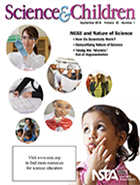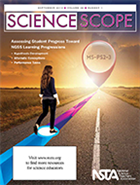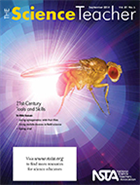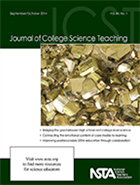NSTA’s K-College Science Education Journals: September 2014 Issues Online
By Lauren Jonas, NSTA Assistant Executive Director
Posted on 2014-09-03
Just as teachers gear up for a new year, so too do NSTA journal editors! We just published our first issues of the school year, and there’s a lot of great science teaching ideas, lesson plans, STEM information, and of course materials to help you learn more about and integrate the Next Generation Science Standards. These journals, while published by the National Science Teachers Association, are full of articles written by your peers in the trenches. So take a minute to catch your breath, and read some of the articles below. Explore the mystery of argumentation, popular science nonfiction, the use of mobile devices in field science, post-secondary STEM education, and more!
 Science and Children
Science and Children
Lessons intended to develop all of the Next Generation Science Standards components must include the nature of science (NOS). But designing those lessons may not be easily accomplished; ways to infuse the NOS are often unclear. The resources in this issue of Science and Children will help deepen your understanding of the NOS and guide you as you cultivate this awareness in your students.
Featured articles (please note, only those marked “free” are available to nonmembers without a fee):
- Demystifying Nature of Science
- Free – Editor’s Note: Learning About the Nature of Science (NOS)
- Free – How Do Scientists Work?
- Integrating the Nature of Science
- Taking the “Mystery” Out of Argumentation
- Three, Two, One … Blast Off!
- Full Table of Contents
Science Scope
 Effective assessment is integral to the three-dimensional learning and teaching needed to realize the vision set forth in the Next Generation Science Standards and A Framework for K–12 Science Education. Use the articles found in this issue to learn how to align your assessment with the three-dimensional learning called for in the new standards.
Effective assessment is integral to the three-dimensional learning and teaching needed to realize the vision set forth in the Next Generation Science Standards and A Framework for K–12 Science Education. Use the articles found in this issue to learn how to align your assessment with the three-dimensional learning called for in the new standards.
Featured articles (please note, only those marked “free” are available to nonmembers without a fee):
- A Penny for Your Thoughts
- Assessing Student Progress Along a Solar System Learning Progression
- Free – Editor’s Roundtable: Align Your Assessments With Three-Dimensional Learning
- Gearing Up for Engineering
- Including Often-Missed Knowledge and Skills in Science Assessments
- Just Do It! Performance Tasks in the Science Classroom
- Free – Magnetism: More Than Just Objects Attracted to Refrigerators
- Moving Ahead With Alternate Conceptions
- Popular Science Nonfiction and the Connection Between Literacy and the NGSS
- Full Table of Contents
 The Science Teacher
The Science Teacher
New technologies—social media and cloud computing, mobile smart devices, “big data,” advanced computational modeling, and countless others—could revolutionalize science teaching and learning. While such advances make new classroom activities possible, the Next Generation Science Standards require us to rethink how we deliver science instruction. The pedagogical foundation provided by the NGSS can combine with new technology to create more engaging learning experiences for all students. Science teachers must lead the 21st-century skills movement. The articles in this issue of The Science Teacher describe teaching with a sample of new technologies, none of which would have been possible a mere decade ago.
Featured articles (please note, only those marked “free” are available to nonmembers without a fee):
- Cellulose Breakdown
- Free – Editor’s Corner: Science Teaching and Learning in the 21st Century
- Going Viral
- Lights and Larvae
- Supporting Newly Hired Science Teachers
- Free – Using Mobile Devices in Field Science
- Full Table of Contents
 Journal of College Science Teaching
Journal of College Science Teaching
An article in the Two-Year Community column describes a dual-enrollment program that gives high school students an opportunity to experience college science in a supported environment, along with lessons learned and challenges faced by faculty when setting up such a program. Also, read how one group of investigators examined whether short “Kahn style” video lectures, assigned as homework, could replace live classroom lectures in the presentation of buffer theory and problem solving. This issue also has an article on the development and evaluation of graduate teaching assistant learning communities to enhance the implementation of inquiry experiences in undergraduate laboratories.
Featured articles (please note, only those marked “free” are available to nonmembers without a fee):
- A Case Study for Teaching Quantitative Biochemical Buffer Problems Using Group Work and “Khan Style” Videos
- A Comparative Study of Instructor- and Student-Led Learning in a Large Nonmajors Biology Course: Student Performance and Perceptions
- Aeronautical Engineering and Aerospace Engineering: A Learner-Centered Teaching Perspective in Higher Education
- Can Graduate Teaching Assistants Teach Inquiry-Based Geology Labs Effectively?
- Free – How Does Undergraduate Research Experience Impact Career Trajectories and Level of Career Satisfaction: A Comparative Survey
- Improving Postsecondary STEM Education: Strategies for Successful Interdisciplinary Collaborations and Brokering Engagement With Education Research and Theory
- Research and Teaching: Emotion, Engagement, and Case Studies
- Research and Teaching: Training the Foot Soldiers of Inquiry: Development and Evaluation of a Graduate Teaching Assistant Learning Community
- Full Table of Contents
Get these journals in your mailbox as well as your inbox—become an NSTA member!
The mission of NSTA is to promote excellence and innovation in science teaching and learning for all.
Follow NSTA
| |
|
|
|
Disclaimer: The views expressed in this blog post are those of the author(s) and do not necessarily reflect the official position of the National Science Teaching Association (NSTA).


